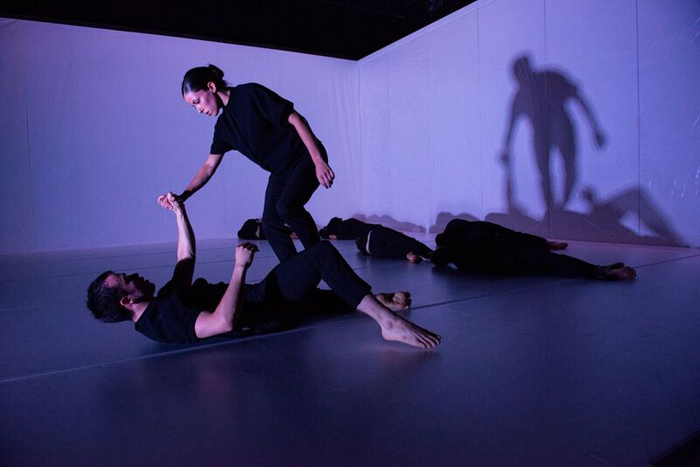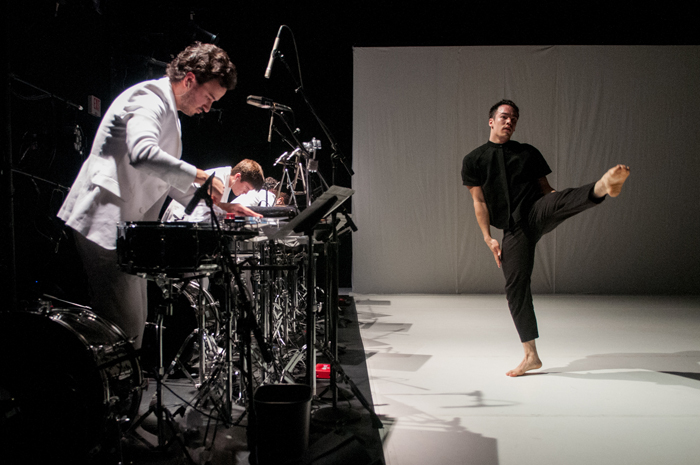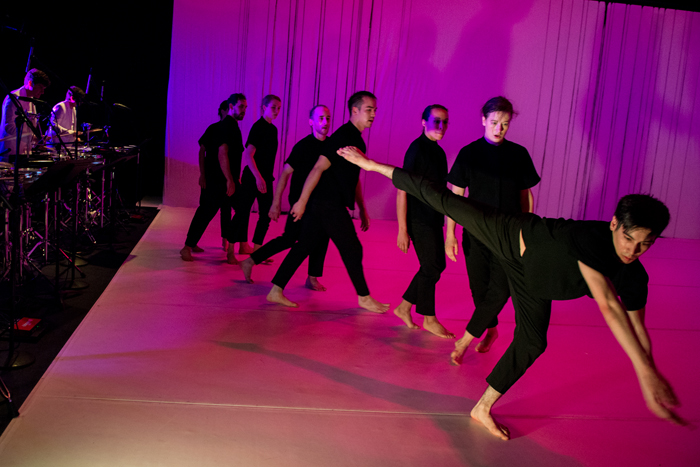Wilderness
Mira Dayal
July 2016


Brian Brooks, Wilderness
The Kitchen
In a strange procession, four musicians in white suits filed on stage to settle at their positions along the left wall. Each wore white earbuds and took up a pair of drum sticks while facing their instruments abutting the stage: marimbas, drums, and iPads. Their scores must have been simple yet individual, for each sustained his own slow beat. Throughout the show, these musicians seemed to simultaneously lead, narrate, and describe the movements of the dancers who walked in soon after. Brian Brooks’s Wilderness toyed with such notions of singularity and coordination, asking the audience to engage with the pattern recognition exercises that must have led to the development of this choreography. But while the dance is purported to juxtapose chaos with order, the real interest was in the triumph of order (or the triumph of one affective genre of gestures) throughout each phase of apparent decay.
Two at first, then six more, the dancers hold lunges until one moves in a jolt, causing the others to scatter. They hold their gazes askew and remove their jackets, fully confronting neither the audience nor their fellow dancers. The percussionists weave a more fluid, watery rhythm, less pointed than before, as the lights brighten and the dancers bounce gently off of each other. If a dancer becomes isolated, they quickly search out another mate. Then, as the volume of the percussion increases and becomes more dynamically punctuated, the dancers begin to pull each other in closer, grabbing limbs and stretching bodies. They fluidly form a line, gliding as if an amoeba. Now, breaking apart again, they link elbows, then trickle their hands across each other’s backs.
Holding a waist or armpit, lifting a leg, or guiding a body to the floor become strangely inhuman gestures. They are either too gentle or too communal to be understood on this scale, performed uniformly across bodies. There is something to this mass mindset that carries the piece forward. In each phase of the dance, I begin to recognize how specific animal behaviors I have observed—such as ducks swimming together across a lake, primates grooming each other by picking out fleas, or ants walking over hills in single file—seem to have been magnified and used as the basis for the types of relationship conveyed by the dancers’ movements. The dancers become a single body of interchangeable parts, which is to say that I begin to see them as patterns rather than individuals. In the line of ants, for example, I am interested in the geometries of their paths rather than their individual characteristics.
When the pace or volume of percussion changes, this signals a new phase of behaviors and shifts the degree of fluidity. Here, one dancer moves beneath the other like a tumbleweed, attempting to trip her by becoming her bench. But the dancer stays upright, even if her knees bend to sit on the body-bench. Some moves feel serpentine, nearly defying gravity or laws of human propulsion. The dancers join hands, her foot on his knee, his hand on her knee. She climbs over him. Now she walks away while he follows her, benches her again. The others lie still in their scattered formation onstage. The intimacy and speed of their pairing, the pursuit of one after another, the disinterest of their peers, and the simultaneous aggression and pleasure of their interaction is reminiscent of mating routines, of birds and other mammals. Eventually, these two birds die down again along with the music to end, once again, on the floor towards the far right of the stage. This corner becomes a neutral zone, where the dancers congregate to morph into a new type of body. A puddle once, they are now a strange mass of dismembered heads and limbs— disembodied from their individual bodies but now conjoined in a tangled knot; when one limb moves, three torsos move too.
The lights have turned peach. The percussion is more like a rattling vibration. The dancers begin to get up, climbing over one another so that their backs rise above the mass, but only for a moment. Now, huddled, they inch across the floor, pushing one dancer’s body as if she were dead or wounded. They are ants, grieving ants. From here each body moves into a position on all fours, breaking apart gradually. The music remains as low as their bodies.
When the lights rise next, so too does the percussion. Two dancers lie still on the floor, but two groups of three other dancers begin to reverberate, making the same movements across their groups so that it becomes clear this is not body contact improvisation, which it might have been before now. These are rehearsed interactions, capable of being repeated, just like the dances of ants towards sweet apricots. Hold onto that sticky and squirming sensation, for it suits the mood of the room.
After several more iterations of group dynamics mirrored perfectly by the percussionists, one dancer performs individually. Slithering as if in slow motion, he holds his arms backwards. Limbs now move separately from torso and legs, or legs stay static while head rotates. Arms seem to drag the body along. The image of a wounded animal, this dancer’s apparent writhing is not unbeautiful, but his despair is enforced by the elegantly simple soundscape of paper being ripped and amplified while a pen scribbles furiously across another page. These sound clips are performed on stage so that the gesture of ripping a strip of paper mirrors that of floating an arm through the air to pull the body in a new direction. The other dancers, who were previously lying still on the floor, now rise up. Almost as if unaware of their presence, the lone dancer continues to move—or, the way he moves around them as they come to constrain his body simply by standing too close makes it seem as though he’d been moving around them this whole time, fighting their intrusion. Turning this image over, it is just as easy to view this enclosure as a body’s defense mechanism against a foreign or failing bacteria. Attack the disease from within, or flood its environs to cease its discomfort.
A series of more specifically animal gestures follows: humping the floor without using their arms, the dancers look like fish dying on the wooden deck of a ship; standing in a line echoing the movements of only the dancer directly ahead, they seem like irrational primates or one long snake; tip-toeing together in a swarm across the floor, they seem to be a hive of wasps encircling a bear; tracing an invisible line through the air with a loose arm that seems to extend forever, one dancer seems to be a firefly whose trail of light lags behind in the night. As allegorical and interesting as these gestures are, their constant fluidity and group sensibility begins to tire the mind—and perhaps this is part of the message, but more likely it is the duration of the piece that makes these dragging gestures literally drag.
Just before the close of the piece, there is a beautiful phrase where only two dancers remain on stage. Like seaweed, one dancer’s arm plays off the other’s body, alternately caressing and entangling it as if in an invitation to play. As they embrace and spin away from each other, the dancers leave behind a sense of longing that is also homage to the delicacy of two bodies touching. Wilderness in a single gesture is about this touch, which seems to be so tentative and graceful that one arm only touches the raised arm hair of the other.

all photos courtesy of Liz Lynch
Brian Brooks Moving Company
June 9-11, 2016
The Kitchen. ADI/NYC
5 Weeks, 5 NYC Premieres
512 West 19th Street
